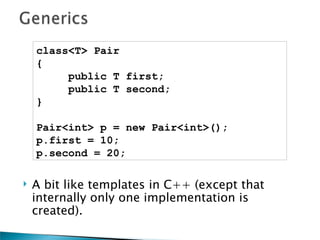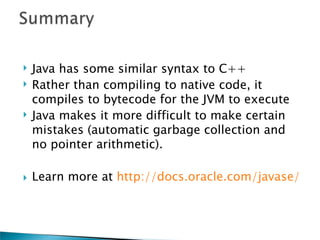Intro to Java for C++ Developers
- 1. Zachary Blair April 10, 2012
- 2. Intro to Java and the JVM Basic Types/Arrays Classes/Inheritance Nested Classes Exceptions Enums Autoboxing/unboxing Annotations Generics
- 3. Originally developed by Sun for embedded devices, version 1.0 released in 1996 James Gosling (Father of Java, Officer of the Order of Canada), photo by Peter Campbell
- 4. Intended as an alternative to C++ that is: ◦ Simpler ◦ Higher-level ◦ Multithreaded ◦ Dynamic ◦ Object-oriented ◦ Trivially portable (“Write Once, Run Everywhere”) ◦ No pointer arithmetic ◦ Automatic garbage collection
- 5. Emulates a “virtual” CPU Java Source Files (.java) Executes “bytecode” javac (each opcode is one byte Java bytecode long) stored in ‘.class’ files (.class) files The same “bytecode” can x86 Java ARM Java run on any machine with Virtual Virtual Machine (JVM) Machine (JVM) a JVM implemented for it
- 6. Not specific to the Java language. Other languages compile for the JVM: ◦ Groovy ◦ Clojure ◦ Jython ◦ JRuby ◦ Dozens of others…
- 7. Similar to C: byte -> 8 bits short -> 16 bits int -> 32 bits long -> 64 bits float -> 32 bits double -> 64 bits char -> 16 bits boolean Numeric types are always signed ‘char’ is a 16 bits instead of 8! No conversion between int and boolean as in C++. if(0) or while(1) are compile-time errors in Java.
- 8. Eight bytes walk into a bar. The bartender asks, “Can I get you anything?” “Yeah,” reply the bytes. “Make us a double.” ** I didn’t come up with this joke, but it’s comedy Gold.
- 9. Similar to C in syntax int[] numbers = new int[10]; numbers[0] = 1000; Arrays are Objects with members and methods (member functions)! for (int i = 0; i < numbers.length; i++) { System.out.println(numbers[i]); } Trying to index past the end of an array results in ArrayIndexOutOfBoundsException
- 10. public class Vector2D { public int x; public int y; public float magnitude() { return Math.sqrt(x * x + y * y); } } Method implementations must be defined in the class body. No ‘.h’ files, just ‘.java’! Classes themselves can have access modifiers! Each ‘public’ class must reside in a ‘.java’ file of the same name (e.g. Vector2D.java).
- 11. public class Velocity extends Point2D { public boolean isTooFast() { return (magnitude() > 60); } } Uses ‘extends’ to specify a base class Only single inheritance is supported All inheritance equivalent to ‘public’ in C++ All classes implicitly inherit from Object
- 12. public class OuterClass { public int var; class InnerClass { public void foo() { System.out.println(var); } } } Non-static inner classes have access to the outer class’s members! Instantiated using ‘this.new’ instead of ‘new’.
- 13. public void foo() { class Point { public int x; public int y; } Point p = new Point(); } You can even declare a class inside a method!
- 14. button.addActionListener(new ActionListener() { public void actionPerformed(ActionEvent e) { System.out.println(“The button was pressed”); } } Defined and instantiated an anonymous class that implements an “ActionListener” interface, all in the parameter list to a method call! Used as Java’s alternative to function pointers in C for callbacks.
- 15. try { int a[] = new int[2]; System.out.println(“A three:" + a[3]); } catch (ArrayIndexOutOfBoundsException e) { System.out.println("Exception:" + e); } Handle error conditions, similar to C++’s try/catch. Some exceptions are ‘checked’, meaning it is a compile-time error to not either catch them, or explicitly mark your method as possibly throwing that exception to its caller.
- 16. public enum Color { RED, ORANGE, YELLOW, GREEN, BLUE } … Color c = Color.RED; Like C enums, but in Java, enum is a sort of class with enum values as static members. You can add data and methods to the enum! Color c = Color.RED; if (c.isWarmColor()) System.out.println(c.toString());
- 17. int x = 10; Integer y = new Integer(x); Integer z = x; int a = z; list list = new List(); list.append(x); // x converted to Integer Automatically convert between primitive types (e.g. int, double, char) to their Object-based (boxed) types (e.g. Integer, Double, Character). Useful because boxed types can be stored in collection classes just like any other Object
- 18. public class Base { public void foo() { } } … public class Subtype extends Base { @Override public void foo() { bar(); } } @Override marks a method as explicitly overriding a base class method, triggering a compilation error if it doesn’t!
- 19. class<T> Pair { public T first; public T second; } Pair<int> p = new Pair<int>(); p.first = 10; p.second = 20; A bit like templates in C++ (except that internally only one implementation is created).
- 20. Java has some similar syntax to C++ Rather than compiling to native code, it compiles to bytecode for the JVM to execute Java makes it more difficult to make certain mistakes (automatic garbage collection and no pointer arithmetic). Learn more at http://docs.oracle.com/javase/

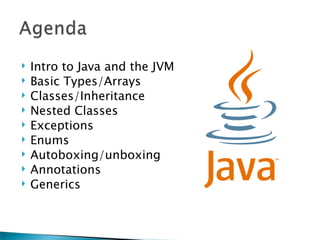
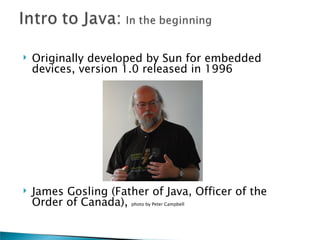
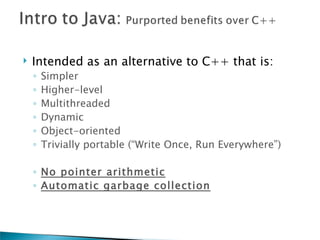
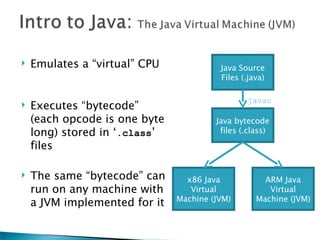
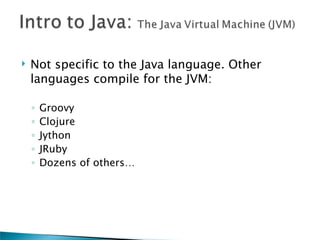


![ Similar to C in syntax
int[] numbers = new int[10];
numbers[0] = 1000;
Arrays are Objects with members and
methods (member functions)!
for (int i = 0; i < numbers.length; i++) {
System.out.println(numbers[i]);
}
Trying to index past the end of an array
results in ArrayIndexOutOfBoundsException](https://image.slidesharecdn.com/introtojavaforcppdevs-120418202551-phpapp02/85/Intro-to-Java-for-C-Developers-9-320.jpg)

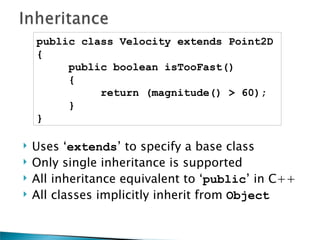


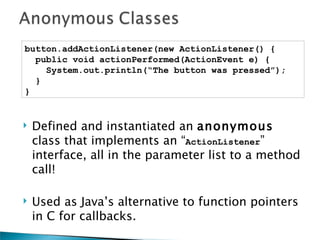
![try {
int a[] = new int[2];
System.out.println(“A three:" + a[3]);
}
catch (ArrayIndexOutOfBoundsException e) {
System.out.println("Exception:" + e);
}
Handle error conditions, similar to C++’s try/catch.
Some exceptions are ‘checked’, meaning it is a
compile-time error to not either catch them, or
explicitly mark your method as possibly throwing
that exception to its caller.](https://image.slidesharecdn.com/introtojavaforcppdevs-120418202551-phpapp02/85/Intro-to-Java-for-C-Developers-15-320.jpg)



